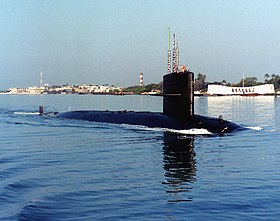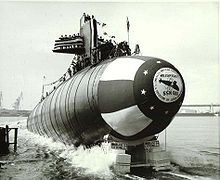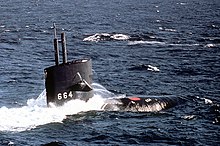Sturgeon class
 The Cavalla in Pearl Harbor |
|
| Overview | |
|---|---|
| Type | Hunting submarine |
| units | 37 built, 0 active |
| Namesake | Real sturgeon |
| period of service |
1967 to 2004 |
| Technical specifications | |
| displacement |
4870–4960 tn.l. submerged |
| length |
89-92.1 meters |
| width |
9.7 meters |
| Draft |
8.9 meters |
| Diving depth | approx. 300 m, depth of destruction approx. 450 m |
| crew |
approx. 105 |
| drive |
S5W pressurized water reactor, one propeller |
| speed |
25 to 30 knots |
| Armament |
4 × 533 mm torpedo tubes |
The Sturgeon-class was a class of nuclear-powered fighter submarines of the United States Navy that were built in the 1960s and 1970s and some were in service until the turn of the millennium. With 37 units, the class was the largest class in the US Navy's hunting submarine fleet in the 1970s until the introduction of the Los Angeles class .
history
Planning & construction
The atomic submarines Sturgeon class were planned in the late 1950s and found an improvement of the preceding Thresher- / Permit class . The boats were as third grade after the Skipjack class and that very Thresher- / Permit class specifically Developed with versatility in mind, so the top speed has not been increased compared to previous classes. Instead, the boats got bigger and the displacement increased. The additional five meters in length compared to the Threshers mainly benefited the noise insulation, the larger tower was equipped with electronics.
The Sturgeon class was the last class to be built at a variety of different shipyards, which is why 37 boats were put into service within eight years. The construction yards were Electric Boat for twelve units, Newport News Shipbuilding for nine submarines, Ingalls Shipbuilding for seven boats, San Francisco Naval Shipyard for five units and Fore River Shipyard and Portsmouth Naval Shipyard for two Sturgeons each .
As far as is known, the construction costs were between 70 and 80 million dollars per unit, with shipyard costs varying widely. While they were under $ 20 million for the early units, the last ones rose to $ 44 million.
Modifications
The last nine boats in the class were lengthened by around three meters from the start, mainly to be able to take more modern sonar systems on board. The USS Parche (SSN-683) was heavily modified in 1978. A 30 meter long fuselage section was inserted in front of the tower, which had a hatch downwards. This enabled the Parche to take over special operations, for which the previous boats USS Hallibut and USS Seawolf were now too old / loud.
The two test ships USS Narwhal (SSN-671) and USS Glenard P. Lipscomb (SSN-685), which tested reactors with natural coolant circuit and turbo-electric propulsion, are also based on the design of the Sturgeon class .
Working time
In the 1960s and 1970s, i.e. at the height of the Cold War , the Sturgeon class , with its two predecessor classes, made up the main part of the hunting submarine fleet. The introduction of the Los Angeles class began in the mid-1970s . They replaced the Sturgeons after around 30 years of service. The Sturgeons were decommissioned between 1991 and 2005. It was formerly planned to replace the boats with the Seawolf-class units , but only three boats of this class were built after the end of the Cold War, which led to a general downsizing of the fleet with the decommissioning of the Sturgeons .
technology
hull
The Sturgeons were built in two versions. While the first 28 units were 89 meters long, the last nine boats were lengthened by around ten feet to 92.1 meters. The long boats received additional living and working space, but also more electronics. The width was 9.7 meters, the draft 8.9 meters. The displacement with full payload was 4870 or 4960 ts submerged. The hull was built in the hydrodynamically favorable teardrop shape, which maximizes the speed under water, but leaves a wide bow wave on the surface and thus consumes energy (and thus speed).
The down rudders were attached to the tower, the span of this totaled 11.6 meters. The oars could be brought into a vertical position to make it easier to emerge through arctic ice; the tower and the upper parts of the hull were specially reinforced for this purpose. The tower was also much larger than on the previous boats, which increased the water resistance and thus cost speed, but also offered more space for antennas. At the stern there was a rudder cross that steered the boat like the rudder of an airplane.
The division of the interior was based on the current design: the torpedo room was located in the bow, behind it, under the tower, the operations center, from which the boat was controlled and commanded. Roughly the rear half belonged to the propulsion system with the reactor chamber, which was located as far as possible in the center of the boat due to its heavy weight. The engine room was in the rear.
Six of the long Sturgeons were equipped to carry a dry deck shelter behind the tower . This chamber makes it easier for divers to enter and exit the submerged boat. In addition, the boats were able to transport the Deep Submergence Rescue Vehicles of the Mystic class .
The maximum permitted diving depth was approx. 400 meters, the depth of destruction was approx. 200 meters deeper, i.e. approx. 600 meters.
drive
The drive consisted of a pressurized water reactor of type S5W ( S for submarine, 5 for the fifth generation of nuclear reactors, W for the manufacturer, Westinghouse Electric Corporation ), which drove two geared turbines . These were connected by a shaft to a propeller that ultimately propelled the ship. In order to avoid cavitation and thus the development of noise as much as possible, the propeller consisted of seven sickle-shaped blades with a length of around six feet or 1.8 meters. Together with the three foot hub, the propeller was 15 feet or 4.5 meters high.
The system's output was 20,000 hp. Thanks to the plutonium core, the range of the submarine was virtually unlimited; the reactor only needed to be refilled with nuclear fuel every 60,000 nautical miles. The maximum speed under water was between 25 and 30 knots, while only 15 knots were possible on the surface due to the hull shape mentioned.
Armament
The armament of the Sturgeon-class boats consisted of four torpedo tubes with a diameter of 553 mm, which were integrated into the hull under the tower at an angle slightly outward.
The boats come from the first generation of multi-mission boats. While at the beginning of their career they could only carry torpedoes , sea mines , usually of the Mark 60 CAPTOR type , as well as the UUM-44 Subroc , during their service time both the anti-ship missile UGM-84 Harpoon and the cruise missile BGM-109 Tomahawk were developed and launched released from the four torpedo tubes. This also made it possible to attack distant sea and land targets. From 1972 the new Mark 48 heavyweight torpedo was established as the new standard on the Sturgeons .
electronics
At the beginning, the boats had the sonar system BQQ-2 , the main battery of which was the actively and passively working spherical sonar BQS-6 in the bow. The later units received the BQQ-5 instead , which takes advantage of part of the extra three meters on the last nine Sturgeons . Like its predecessor, this active / passive sonar is also located in the bow behind a fiberglass cap and was also used on modern Los Angeles class boats. It was also retrofitted on older boats in the class in the 1970s. The Sturgeons were also the first boats to receive a tow sonar .
The boats have a BPS-14 or BPS-15 on one of the masts as radar . There were also two different periscopes , which differed in terms of image quality and radar reflective surface , and a total of four antennas for electronic warfare .
Mission profile
As hunting submarines, the Sturgeons performed the tasks typical of this class. This includes escort trips for aircraft carrier combat groups as well as the shading of enemy missile submarines . Another task was to guard the so-called GI-UK gap in order to prevent the Soviet Navy from breaking through into the Atlantic.
Since the Sturgeon class, as already mentioned, had a larger tower and thus more antennas for electronic warfare than its predecessor, an important area of application for the boats was espionage. According to a study by the Center of Science and International Affairs at Havard University, the Sturgeon-class submarines undertook around 100 reconnaissance and espionage trips in sovereign waters of the Soviet Union from 1961 to 1975. The purpose of such trips could, for example, be to eavesdrop on enemy communications or to spy on ship prototypes during their test drives.
As the boats were specially equipped for under-ice operations, as mentioned, surfacing through arctic ice was practiced regularly. The ability to operate in polar regions was particularly useful when tracking the Soviet missile submarines of the Typhoon class, for example , which frequently patrolled these regions.
Misfortunes and incidents
The 17th unit of the class, the USS Guitarro (SSN-665) , had a rather bizarre accident: while the boat was being equipped, it sank in about ten meters deep water. Two groups of shipyard workers independently filled and emptied the boat's ballast tanks at the same time, with it submerging at the front and massive water running into the boat through open hatches.
The third unit, the USS Tautog (SSN-639) , collided with the Soviet submarine K-108 on its first voyage in 1970 off Petropavlovsk-Kamchatsky . For years it was assumed in the Navy that the K-108 had sunk. It was only around the year 2000 that it became known that she too had made it back to her home port. Whole pieces of the Soviet screw were found in the tower of the Tautog . The USS Grayling (SSN-646) also collided with a Russian submarine in 1993, and both boats returned damaged to their ports.
An incident occurred in the port of Vladivostok between 1961 and 1975 when a Sturgeon-class submarine tried to photograph the underside of a Soviet submarine and collided with the boat, albeit without causing any major damage.
Other accidents involving Sturgeon-class boats include, in addition to other minor collisions during exercises and maneuvers, the outbreak of fire or grounding.
Web links
- Sturgeon class on globalsecurity.org (English)
Footnotes
- ^ Stefan Terzibaschitsch : Sea power USA. Volume 2. Bechtermünz-Verlag, Augsburg 1997, ISBN 3-86047-576-2 , p. 507.
- ^ Paul Forsythe Johnston, The National Museum of American History: The Taming of the Screw (Page 6 )
- ↑ Der Spiegel No. 17, April 21, 1986, p. 14.
- ↑ Accident Report of the Navy .
- ^ Sherry Sontag, Christopher Drew: Hunt under water. The real story of submarine espionage. Bertelsmann Verlag, Munich 2000, ISBN 3-570-00425-2 .
- ↑ Der Spiegel No. 17, April 21, 1986 p. 14.
- ↑ Seymour M. Hersh : Submarines of US Stage Spy Missions Inside Soviet Waters. In: The New York Times . May 25, 1975.





